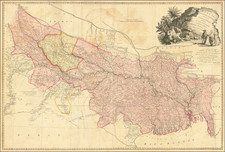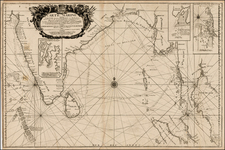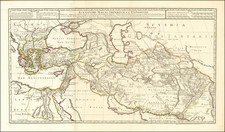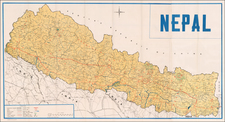A map of the Sikh Empire
Highly detailed map of the Northern India, Pakistan and Nepal, published in 1849 by John Arrowsmith.
The map shows the soon to be dissolved region created through conquest by the Maharaja Ranjit Singh (1780-1839). Singh was the founder and first ruler of the Sikh Empire. beginning as a misldar (baron) in the Punjab, Singh had taken control of the entire region by 1800. By the time he died, the Sikh Empire covered Punjab, Kashmir, and parts of modern day Afghanistan, Tibet and China.
Singh is most famous for the secular tolerance of his empire and for his ownership of the Koh-i-Noor diamond. Ranjit Singh left the diamond to a temple in his will on his death in 1839, but his wishes were ignored by British administrators. A decade later, the Punjab, and thus the diamond, came under the control of the East India Company and the stone was given to Queen Victoria.
When this map was printed the Sikh Empire was on the brink of dissolution. After Ranjit Singh's death, a series of short-lived rulers took the throne, often dying under suspicious circumstances. The East India Company took advantage of this internal weakness to launch the Anglo-Sikh Wars, which culminated in the separation of the empire back into princely states under the supervision of a British Lieutenant Governor in Lahore in 1849. The region was, therefore, of renewed interest to British observers, possibly explaining why Arrowsmith chose to issue the map.
The map noes that it is based upon the manuscript map of Baron Charles von Hügel (1795-1870). Von Hügel, an Austrian statesman and scientist, made a five year tour of Asia in 1831 His Kashmir and the Realm of the Sikh', was tremendously influential, resulting in his being awarded the Patron's Medal by the Royal Geographical Society.
Rarity
The map is quite rare on the market. We note only 2 prior examples at auction and in dealer catalogs.
The Arrowsmiths were a cartographic dynasty which operated from the late-eighteenth century to the mid-nineteenth. The family business was founded by Aaron Arrowsmith (1750-1823), who was renowned for carefully prepared and meticulously updated maps, globes, and charts. He created many maps that covered multiple sheets and which were massive in total size. His spare yet exacting style was recognized around the world and mapmakers from other countries, especially the young country of the United States, sought his maps and charts as exemplars for their own work.
Aaron Arrowsmith was born in County Durham in 1750. He came to London for work around 1770, where he found employment as a surveyor for the city’s mapmakers. By 1790, he had set up his own shop which specialized in general charts. Arrowsmith had five premises in his career, most of which were located on or near Soho Square, a neighborhood the led him to rub shoulders with the likes of Joseph Banks, the naturalist, and Matthew Flinders, the hydrographer.
Through his business ties and employment at the Hydrographic Office, Arrowsmith made other important relationships with Alexander Dalrymple, the Hudson’s Bay Company, and others entities. In 1810 he became Hydrographer to the Prince of Wales and, in 1820, Hydrographer to the King.
Aaron Arrowsmith died in 1823, whereby the business and title of Hydrographer to the King passed to his sons, Aaron and Samuel, and, later, his nephew, John. Aaron Jr. (1802-1854) was a founder member of the Royal Geographical Society (RGS) and left the family business in 1832; instead, he enrolled at Oxford to study to become a minister. Samuel (1805-1839) joined Aaron as a partner in the business and they traded together until Aaron left for the ministry. Samuel died at age 34 in 1839; his brother presided over his funeral. The remaining stock and copper plates were bought at auction by John Arrowsmith, their cousin.
John (1790-1873) operated his own independent business after his uncle, Aaron Arrowsmith Sr., died. After 1839, John moved into the Soho premises of his uncle and cousins. John enjoyed considerable recognition in the geography and exploration community. Like Aaron Jr., John was a founder member of the RGS and would serve as its unofficial cartographer for 43 years. Several geographical features in Australia and Canada are named after him. He carried the title Hydrographer to Queen Victoria. He died in 1873 and the majority of his stock was eventually bought by Edward Stanford, who co-founded Stanford’s map shop, which is still open in Covent Garden, London today.










![Tabula Asiae XI [Southeast Asia]](https://storage.googleapis.com/raremaps/img/small/95794.jpg)



